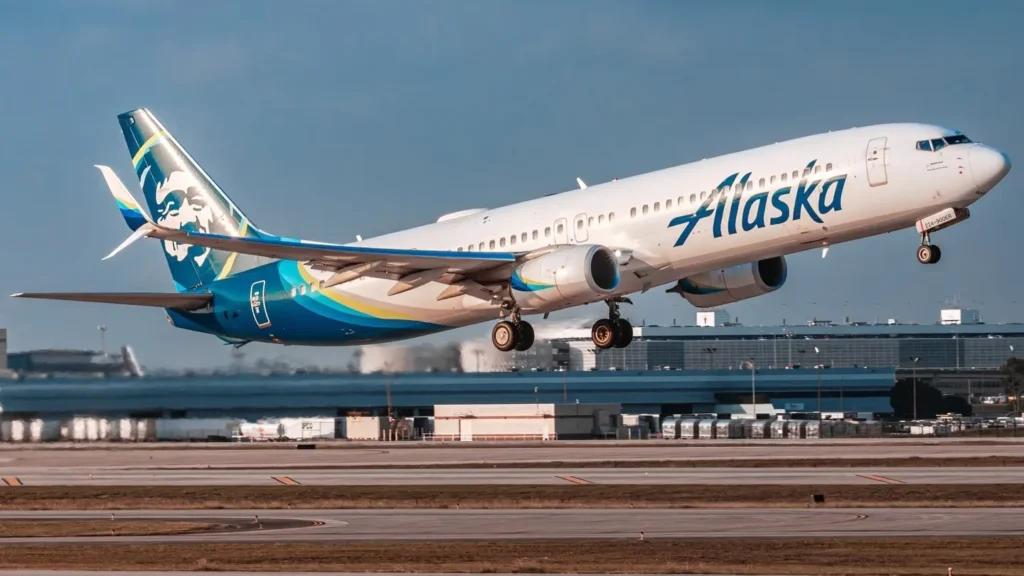
Alaska Airlines (AS), давно известная своими глубокими корнями на северо-западе Тихого океана, управляет одной из самых региональных, но стратегически эффективных внутренних сетей в Соединенных Штатах.
В то время как его название может вызвать образы заснеженных вершин и северной пустыни, операции авиакомпании в значительной степени сосредоточены вокруг Сиэтла и Портленда, служа спасательными линиями не только для Аляски, но и для всего коридора Западного побережья.
Кроме того, маршрутная сеть представляет собой авиакомпанию, расширяющую свои горизонты, не покидая свою домашнюю базу.
Анализ 30 самых загруженных внутренних маршрутов Аляски по рейсам, местам и ASM показывает, что перевозчик остается верным своему ядру, постепенно наращивая силу на трансконтинентальных рынках.
 Фото: Tomás Del Coro; Wikimedia Commons
Фото: Tomás Del Coro; Wikimedia CommonsПостроен в Сиэтле Stronghold
Сиэтл (SEA) является не только основной базой авиакомпании Alaska Airlines, но и стратегической и исторической связью компании. 22 из 30 самых загруженных внутренних маршрутов авиакомпании начинаются или заканчиваются в Сиэтле.
Самый загруженный из всех, Анкоридж-Сиэтл, возглавляет список с более чем 1000 ежемесячных рейсов, 175 000 мест и колоссальными 253 миллионами доступных миль мест (ASM). Это подчеркивает постоянную силу Аляски в соединении штата Аляска с материковой частью США.
Связь Сиэтла доминирует Калифорнийские маршруты также с густыми частотами в Лос-Анджелес (612 ежемесячных рейсов), Сан-Диего (530), Сан-Франциско (576) и Санта-Ана (434). С помощью около 500 ежемесячных рейсов связь с крупными юго-западными рынками, такими как Феникс и Лас-Вегас, по-прежнему показывает, как Аляска переносит как отдых, так и технически подкованный бизнес-трафик из Сиэтла.
Даже другие вторичные хабы Западного побережья, такие как Спокан, Бербанк, Онтарио и Сакраменто, имеют приличные частоты в Сиэтле, укрепляя то, как фактически работает авиакомпания Alaska Airlines как внутрирегиональное соединение Тихоокеанского Северо-Запада и за его пределами.
 Источник: Clément Alloing
Источник: Clément Alloing«Тихая сила» Портленда и Калифорнийская сеть
В то время как внимание Аляски к Сиэтлу доминирует в заголовках, Портленд (PDX) занимает второе место по значимости, особенно для доступа к Южной Калифорнии.
Маршруты Портленд-Сан-Диего (285 отправлений), Портленд-Санта-Ана (248) и Портленд-Сан-Франциско (230) иллюстрируют это. Портленд-Феникс также занимает высокое место с более чем 40 000 мест и 41 миллионом ASM, показывая, как Аляска сохранила Портленд оплотом, даже когда другие отступают.
Доминирование Калифорнии в сети Аляски также очевидно за пределами северо-западных коридоров. Лос-Анджелес-Сиэтл является вторым по загруженности маршрутом в своей сети, и Аляска играет важную роль в путешествиях между Калифорнией и соседними рынками.
Аляска связывает LAX с Портлендом, Сан-Франциско с Сиэтлом и Сан-Хосе с Сиэтлом — все ведущие маршруты по местам.
Этот сильный фонд Западного побережья предоставляет высокочастотные услуги корпоративным путешественникам, а также служит воротами на рынки отдыха, в первую очередь из Калифорнии на Тихоокеанский северо-запад и Аляску.
 Источник: Cado Photo
Источник: Cado PhotoРасширение сети: Трансконы и связи Аляски
Alaska Airlines постепенно развивает трансконтинентальное присутствие на дальних расстояниях, часто за счет слотов в аэропортах с высокой загруженностью, таких как JFK и DCA.
Маршруты JFK-Seattle и JFK-San Francisco входят в топ-30, демонстрируя амбиции Аляски на высокооплачиваемых бизнес-рынках.
Не следует упускать из виду роль Аляски в соединении внутренних районов Аляски с нижними 48. Помимо Anchorage-Seattle, такие связи, как Fairbanks-Seattle и Juneau-Seattle, остаются одними из самых загруженных, с почти 300 комбинированными секторами и более 100 000 ASM.
Эти маршруты являются источником жизненной силы для жителей штата и обеспечивают уникальную идентичность бренда Аляски, балансируя между городом, отдыхом и жизненно важными функциями воздушного сообщения.
Маршруты Аляска-Аляска, такие как Анкоридж-Юно и Кетчикан-Сиэтл, продолжают занимать место в топ-30, что отражает постоянную приверженность перевозчика своему родному штату, несмотря на его стремление доминировать на более крупных полях сражений, таких как Остин (AUS-SEA) и Бостон (BOS-SEA).
| Ранг | Маршрут | Полеты | Места | АСМ |
| 1 1 | Anchorage (ANC) — Сиэтл (SEA) | 1,044 | 174 812 | 253 127 776 |
| 2 2 | Лос-Анджелес (LAX) — Сиэтл (SEA) | 61212 | 104 034 | 99 248 436 |
| 3 | Сиэтл (SEA) — Сан-Франциско (SFO) | 576 | 100 220 | 68 049 380 |
| 4.4 | Сан-Диего (SAN) - Сиэтл (SEA) | 530 | 91 087 | 95 641 350 |
| 5 | Phoenix (PHX) — Сиэтл (SEA) | 513 | 89 604 | 99 191 628 |
| 6.6 | Лас-Вегас (LAS) — Сиэтл (SEA) | 493 | 84 462 | 73 144 092 |
| 7. | Сиэтл (SEA) — Санта-Ана (SNA) | 434 | 69 063 | 67 543 614 |
| 8 | Chicago-O’Hare (ORD) — Сиэтл | 368 | 64 554 | 111 097 434 |
| 9 9 | Лос-Анджелес (LAX) — Портленд (PDX) | 366 | 62 032 | 51 734 688 |
| 1010 | Даллас / Форт-Уэрт (DFW) - Сиэтл (SEA) | 344 | 60 548 | 100 509 680 |
| 11. | Сиэтл (SEA) — Сан-Хосе (SJC) | 342 | 58 027 | 40 444 819 |
| 12. | Burbank (BUR) - Сиэтл (SEA) | 292 | 49 837 | 46 697 269 |
| 13 | Портленд (PDX) — Сан-Диего (SAN) | 285 | 49 555 | 46 234 815 |
| 14 | Fairbanks (FAI) — Сиэтл (SEA) | 282 | 45 695 | 70 050 435 |
| 15 | Денвер (ДЕН) - Сиэтл (SEA) | 277 | 48 419 | 49 581 056 |
| 16 | Спокан (GEG) — Сиэтл (SEA) | 266 | 46 854 | 10 448 442 |
| 177 | Джуно (JNU) — Сиэтл (SEA) | 253 | 37 805 | 34 364 745 |
| 18 | Нью-Йорк-JFK (JFK) - Сан-Франциско (SFO) | 248 | 43 555 | 112 633 230 |
| 19 | Нью-Йорк-JFK (JFK) - Сиэтл (SEA) | 248 | 43 536 | 105 400 656 |
| 20 | Портленд (PDX) — Санта-Ана (SNA) | 248 | 39 438 | 33 877 242 |
| 21 | Лас-Вегас (LAS) - Портленд (PDX) | 235 | 41 165 | 31 367 730 |
| 22. | Онтарио (ONT) — Сиэтл (SEA) | 230 | 39 583 | 37 841 348 |
| 23 | Портленд (PDX) — Феникс (PHX) | 230 | 40 598 | 40 963 382 |
| 24 | Портленд (PDX) — Сан-Франциско (SFO) | 230 | 39 841 | 21 912 550 |
| 25 | Сиэтл (SEA) - Сакраменто (SMF) | 224 | 39 036 | 23 616 780 |
| 26 | Сиэтл (SEA) — Солт-Лейк-Сити (SLC) | 222 | 37 535 | 25 861 615 |
| 27 | Остин (AUS) — Сиэтл (SEA) | 220 | 38 400 | 67 968 000 |
| 28 | Анкоридж (ANC) - Джуно (JNU) | 220 | 27 770 | 15 856 670 |
| 29 | Бостон (BOS) — Сиэтл (SEA) | 220 | 38 780 | 96 794 880 |
| 30 | Кетчикан (KTN) — Сиэтл (SEA) | 220 | 28 546 | 19 382 734 |
Нижняя линия
Авиакомпания Alaska Airlines может прочно закрепиться в Сиэтле и на Большом Тихоокеанском Северо-Западе, но состав ее самых загруженных внутренних маршрутов показывает, что сеть отнюдь не застойна.
Перевозчик поднимает плотность Западного побережья, постепенно расширяясь в трансконтинентальную почву и поддерживая критические жизненные линии во внутренних районах Аляски.
На консолидирующемся и конкурентном рынке США Alaska Airlines по-прежнему делает ставку на расширение за счет частоты, надежности и узнаваемой региональной ниши.
Оставайтесь с нами. Следуйте за нами в социальных сетях для последних обновлений.
Присоединяйтесь к нам в Telegram Group для последних обновлений авиации. Следуйте за нами в Google News
Alaska Airlines объявляет о своем первом европейском направлении с гавайским 787
Авиакомпания Alaska Airlines 30 Busiest Domestic Routes в 2025 году впервые появилась на Aviation A2Z.











![Makabryczne odkrycie w lesie. Tak skończyły się poszukiwania dwóch zaginionych [ZDJĘCIA]](https://www.eostroleka.pl/luba/dane/pliki/zdjecia/2025/271-220209.jpg)





